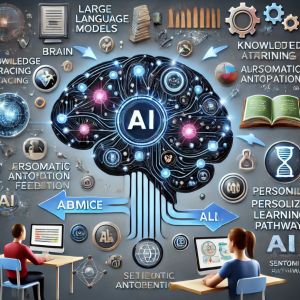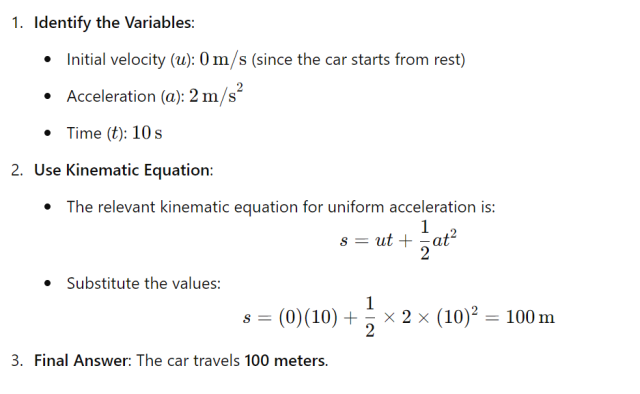
Adaptive learning helps in tailoring learning experiences to fit the unique needs of each student. In the quest to make learning more personalized, Large Language Models (LLMs) with their capability to understand and generate human-like text, offer unprecedented opportunities to adaptively support and enhance the learning process. In this blog, we will explore how adaptive learning can leverage LLMs by integrating Knowledge Tracing (KT), Semantic Representation Learning, and Automated Knowledge Concept Annotation to create a highly personalized and effective educational experience.
What is Adaptive Learning?
Adaptive learning refers to a method of education that levereges technology to adjust the type and difficulty of learning content based on individual student performance. Unlike the traditional one-size-fits-all approach, adaptive learning continuously assesses a student’s progress, strengths, and weaknesses, and provides customized learning pathways to improve understanding and skills.
Adaptive learning platforms utilize data-driven algorithms to create tailored experiences, but integrating LLMs into these systems takes personalization to the next level. By using LLMs, adaptive learning can not only personalize but also deeply understand the nuances of each student’s learning journey, making education both effective and efficient.
How LLMs can be used for Adaptive Learning?
LLMs, such as OpenAI GPT series models, can be integrated into adaptive learning environments in several impactful ways, transforming how students learn and interact with educational content. Here are some core concepts and strategies through which LLMs can enhance adaptive learning:
- Automated Knowledge Concept Annotation
- Semantic Representation Learning
- Knowledge Tracing for Personalized Recommendations
- Generating Contextual Practice Question Papers
- Adaptive Learning Pathways and Real-time Feedback
Let’s explore each of these in more detail.
Automated Knowledge Concept Annotation
One of the core functionalities of adaptive learning is understanding what a student knows and identifying gaps in their knowledge. This requires accurate identification of Knowledge Concepts (KCs) associated with each question or learning activity. Traditionally, this process is often carried out manually by experts, making it time-consuming and inconsistent. Automated Knowledge Concept Annotation using LLMs changes the game by providing an efficient and scalable solution. The following is how LLMs can be levereged:
- LLMs are used to generate detailed solutions to questions and automatically annotate them with relevant KCs. For instance, if a physics question involves calculating acceleration, the LLM can identify related concepts such as Newton’s Second Law, Uniform Acceleration, and Distance Calculation.
- Each question and its associated KCs are stored in the adaptive learning system’s database. This automated annotation ensures that each question is linked to the specific skills and concepts required to solve it.
The following is an example of how knowledge concept annotation can be created using LLMs:
Let’s take a simple physics question:
Question: “A car accelerates uniformly from rest at a rate of 2 m/s². How far does it travel in 10 seconds?”
We need to determine which Knowledge Concepts (KCs) are involved in this question using an LLM. Let’s pass this question to the LLM to generate the solution and identify the key KCs. Here is the LLM anotation process based on identifying different solution steps:

Based on the above, the identified knowledge concepts can be the following:
- Kinematic equation of motion
- Uniform acceleration
- Displacement calculation
Semantic Representation Learning
Semantic Representation Learning with LLMs involves generating meaningful numerical embeddings (vector representations) for questions, solutions, and knowledge concepts. These embeddings encode not only the content but also the contextual relationships between them. The following is how it works:
- An LLM processes a question and generates an embedding that represents the semantic content of the question. This includes the specific KCs, difficulty level, and underlying concepts.
- Similarly, embeddings are created for KCs and solution steps, creating a semantic representation of each learning activity.
The following is how the semantics representations (embeddings) is used in adaptive learning:
- Similarity Analysis: Embeddings are used to identify similarities between different questions. For example, questions involving “Projectile Motion” and “Uniform Acceleration” in physics will have similar semantic representations, allowing the system to identify which questions are related.
- Personalized Question Selection: The adaptive learning platform can use semantic similarity to select the most appropriate questions for a student based on their past performance. If a student struggled with a question on “Differential Equations,” the platform can recommend similar questions that target the same concept, but perhaps with a different difficulty level or a different approach.
Here is how the usage of semantic representation used in adaptive learning can be impactful:
- Deeper Understanding: Semantic representation learning allows the adaptive system to understand not only the content of a question but also the relationships between different concepts. This ensures that the learning path recommended to a student is more aligned with their specific needs.
- Efficient Learning Pathways: By leveraging the similarity between concepts, the adaptive system can provide targeted practice questions that help students strengthen weak areas without overwhelming them.
Knowledge Tracing for Personalized Recommendations
Knowledge Tracing (KT) is the process of estimating a student’s knowledge state over time by analyzing their past performance. KT plays a crucial role in adaptive learning by providing insights into what a student knows and predicting which questions they are likely to answer correctly in the future. Here is how LLMs can be levereged in KT:
- The student’s performance on each question is recorded, and their knowledge state is updated accordingly.
- By using semantic embeddings, the KT model can determine how well a student understands a particular concept based on their interactions with related questions. If a student consistently struggles with questions involving “Linear Equations,” the system identifies this as a weak area.
- Based on the student’s current knowledge state, LLMs recommend the most appropriate next steps for the student. For example, if a student struggles with “Linear Equations,” the system may recommend simpler questions or interactive tutorials to reinforce foundational concepts.
- The KT model continuously adapts as the student progresses, ensuring that the recommended content remains relevant and challenging enough to promote growth.
Generating Contextual Practice Question Papers
Another significant way adaptive learning can leverage LLMs is in the generation of practice question papers. By creating custom question sets, the system can provide targeted practice that focuses on specific KCs. Here is how LLMs can be levereged:
- Question generation using LLMs: LLMs can generate practice questions based on specific KCs or learning objectives. For example, if a student needs more practice in “Thermodynamics” in chemistry, the LLM can generate a set of questions that cover different aspects of thermodynamics, ranging from basic principles to more complex problem-solving.
- Semantic Filtering: The generated questions are evaluated using their semantic embeddings to ensure they match the desired difficulty level and content. Only the most relevant questions are included in the practice paper.
Adaptive Learning Pathways and Real-time Feedback
The ultimate goal of adaptive learning is to provide a personalized learning experience that adapts in real-time to the needs of each student. By leveraging LLMs, adaptive learning systems can offer tailored learning pathways and provide instant feedback. Here is how LLMs can be levereged:
- Real-time Analysis: LLMs analyze student performance data and determine the next set of learning activities. For instance, if a student successfully solves questions involving “Newton’s Laws of Motion,” the system can recommend more advanced topics like “Rotational Dynamics.”
- Instant Feedback and Explanation: LLMs can also provide instant feedback and detailed explanations for incorrect responses. If a student gets a question wrong, the LLM can generate a step-by-step explanation to help them understand their mistake.
Example: Adaptive Learning in Physics using LLM
Let’s consider a student preparing for the JEE entrance exam in physics. The student is working on questions related to “Projectile Motion.”
- Automated Annotation: The LLM annotates the questions with KCs such as “Kinematic Equations,” “Vertical Motion,” and “Horizontal Displacement.”
- Semantic Representation: Each question is represented by an embedding that encodes its relationship to the various KCs.
- Knowledge Tracing: The student’s performance is tracked over time. If they struggle with calculating the range of a projectile, the system recognizes this and identifies it as a weak point.
- Targeted Practice: The adaptive system uses the KC embeddings to identify similar questions related to “Projectile Motion” and provides a customized practice set to help the student master the topic.
- Real-time Feedback: When the student answers a question incorrectly, the LLM generates an explanation, helping them understand how to approach similar questions in the future.
Conclusion
Adaptive Learning, when combined with Large Language Models, holds the potential to significantly enhance personalized education. LLMs offer powerful tools for automating knowledge concept annotation, creating semantic representations, tracking knowledge, and providing personalized recommendations. By understanding the nuances of a student’s learning journey, LLMs enable adaptive learning systems to create highly tailored learning pathways that promote better outcomes.
The integration of semantic representation learning ensures that learning activities are deeply understood and related, providing students with content that is not only relevant but also challenging and engaging. As education moves further into the digital age, the synergy between adaptive learning and LLMs promises a future where each student receives the individualized support they need to thrive.
Check out this paper for detailed learning on knowledge tracing and how LLMs can be used: Automated knowledge concept annotation and question representation learning for knowledge tracing.
- Coefficient of Variation in Regression Modelling: Example - November 9, 2025
- Chunking Strategies for RAG with Examples - November 2, 2025
- RAG Pipeline: 6 Steps for Creating Naive RAG App - November 1, 2025
I found it very helpful. However the differences are not too understandable for me